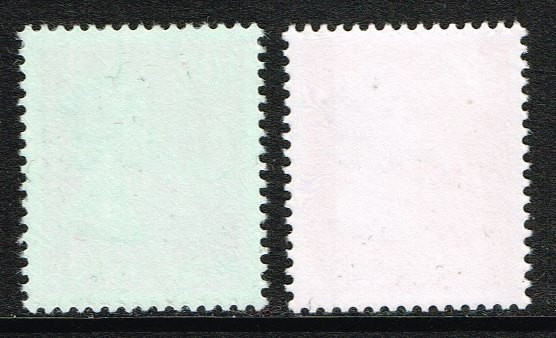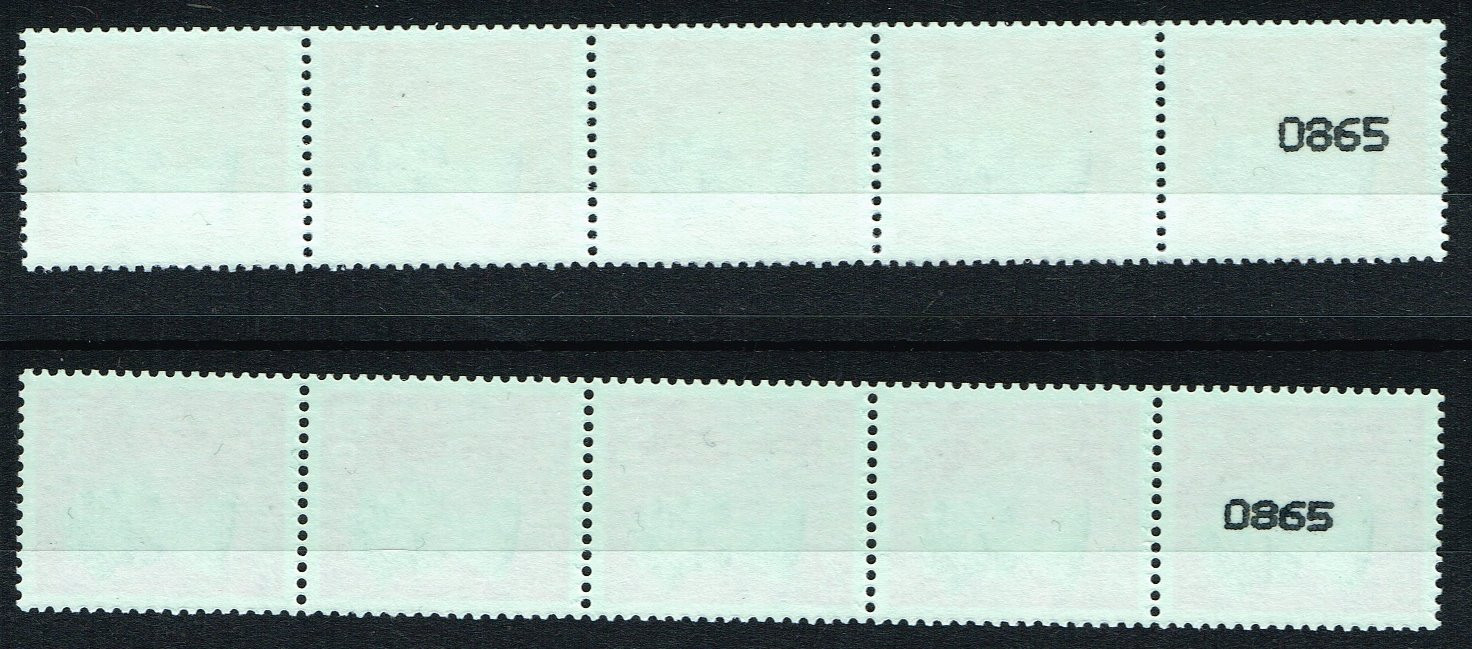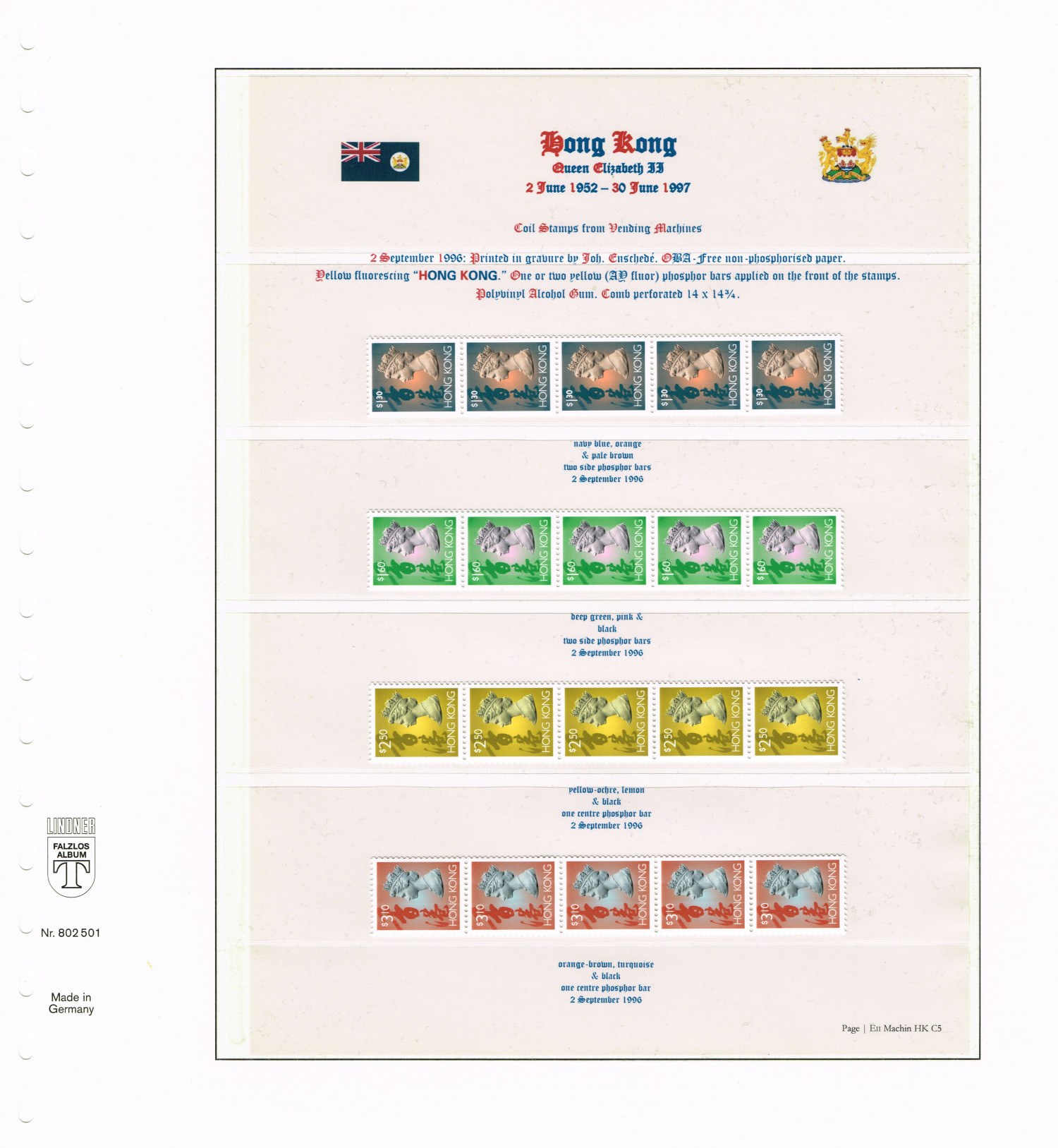| Author |
 Replies: 68 / Views: 7,383 Replies: 68 / Views: 7,383 |
|
|
|
Pillar Of The Community
Netherlands
5356 Posts |
|
|
Below image shows the two gums used by Joh. Enschedé. Both stamps have polyvinyl-alcohol gum. The stamps are the 10c without (left) phosphor bars with a bluish gum, and with (right) phosphor bars with a whitish gum.  Although the three large-format stamps were note issued with phosphor bars, they exist with both bluish and whitish gums. The latter stamps were put into circulation in 1996, alongside the stamps with phosphor bars. I have not yet found a source that offers the two sets. I did see a set offered on Ebay that appeared to have a mixture of the two gums. |
Send note to Staff 
|
|
|
Pillar Of The Community
Netherlands
5356 Posts |
|
|
The Hong Kong Post Office also sold its stamps from stamp vending machines. The machines could dispense four different values at any one time.  picture of Hong Kong stamp vending machine from Wikimedia picture of Hong Kong stamp vending machine from WikimediaJoh. Enschedé printed the stamps. The printers printed British coil stamps on a continuous web of 10 columns with margins on both sides. After printing, the web was reeled into rolls of 1,000 stamps that were cut into columns. They may have used the same process for printing the Hong Kong coil stamps. The stamps were printed in gravure on OBA-free non-phosphorised paper with a whitish polyvinyl-alcohol gum. All coil stamps have the small format and a 15 x 14 perforation gauge. They, generally, exist with both upright and inverted printings. Some coil stamps exist both with the bluish and with the whitish polyvinyl-alcohol gum. On 16 June 1992, six coil stamps were issued. The 10c and 50c are not known to have been available from the vending machines at post offices. They were used by businesses and available from machines installed at office buildings. They remained available throughout the lifetime of the series.  The vending machines dispensed the four most used values. The first four denominations available from the vending machines installed at post offices were 80c, 90c, $1.80, and $2.30.  |
Send note to Staff 
|
|
|
Pillar Of The Community
Netherlands
5356 Posts |
|
|
As is the case for sheet stamps, the letters "HONG KONG" of the coil stamps were overprinted with fluorescent ink that reacts yellow under a uv lamp.  Fluorescence under a Leuchtturm long-wave uv lamp Fluorescence under a Leuchtturm long-wave uv lamp |
Send note to Staff 
|
|
|
Pillar Of The Community
Netherlands
5356 Posts |
|
|
Douglas Myall suggests the TCTC-system to identify the source of stamps. Since the reels of coil stamps were cut into columns, the individual stamps will have clean-cut perforation tips on the left and right sides. At top and bottom, the perforation tips will be ragged from tearing stamps apart. I.e., coil stamps will be TCTC: clockwise starting from the top: torn, cut, torn, cut. From some of my own strips, it appears cutting through the reals does not always result in clean-cut perforation tips. After printing the stamps, a number was applied over the gum of every fifth stamp in the roll. It is likely the numbers were applied by individual print heads for each column of stamps. The typeface is not the same for all stamps that were available at the same time. Individual heads may have been replaced, causing the variation in the typeface of the numbers. The philatelic service of the Hong Kong Post Office sold coil strips of five stamps that included a stamp with a number printed on the back.  Numbers on the back of every fifth stamp in the roll Numbers on the back of every fifth stamp in the roll(The strips I post all have matching numbers on the bottom stamps.) |
Send note to Staff 
|
|
|
Pillar Of The Community
Netherlands
5356 Posts |
|
|
The Hong Kong Post Office raised its postage rates on 1 November 1993. From November 1993, the vending machines at post offices dispensed stamps with face values of $1, S1.20, $1.90, and $2.40.  1993, coil stamps from vending machines 1993, coil stamps from vending machinesDaniel Tangri describes how he got his stamps locally. I, therefore, am prone to accept he is correct to give November 1993 as the issue date for all four coil stamps. The $1 and $1.20 covered basic rates from that time. The coil stamps may have been intended to become available, and may have been available through the philatelic service or a vending machine, on the day of the rate increase and issue of two of the stamps. I do not know. Daniel Tangri describes how he got his stamps locally. I, therefore, am prone to accept he is correct to give November 1993 as the issue date for all four coil stamps. The coil stamps may have been intended to become available, and may have been available through the philatelic service, on the day of the rate increase and issue of two of the stamps. I do not know. |
Send note to Staff 
|
|
|
Pillar Of The Community
Netherlands
5356 Posts |
|
|
After the Hong Kong Post Office, again, raised its postage rates on 1 June 1995, the vending machines dispensed stamps of $1.20, S1.50, $2.10, and $2.60. The rolls of stamps with a face value of $1.20, already, had been introduced after the previous increase in postage rates, in 1993. The other three values were new.  1995, coil stamps from vending machines 1995, coil stamps from vending machines |
Send note to Staff 
|
|
|
Pillar Of The Community
Netherlands
5356 Posts |
|
|
As I wrote in an earlier post the Hong Kong Post Office installed two letter-facing and cancelling machines, in April 1996. These used light signals emitted by phosphor after exposure to uv light to, mechanically, face, cancel, and sort letters. To facilitate the mechanical facing and sorting of letters, stamps were overprinted with phosphor bars. The stamps that paid for international airmail had a central phosphor bar. Stamps of lower denominations that prepaid the cost of carriage for local mail and mail to mainland China had two side phosphor bars. These phosphor bars were applied over the coloured ink. On 2 September 1996, the Hong Kong Post Office raised its postage rates. Consequently, the vending machines at post offices dispensed stamps with a face value of $1.30, S1.60, $2.50 and $3.10. The rolls contained stamps with phosphor bars.  1996, coil stamps with phosphor bars from vending machines 1996, coil stamps with phosphor bars from vending machinesThe $2.50 and $3.10 stamps that prepaid rates for international air mail and had a single phosphor bar. The other two stamps had two phosphor bars. The coil stamps with phosphor bars only had the whitish polyvinyl-alcohol gum. The rolls of 10c and 50c stamps remained available. The sheet stamps of these two denominations were issued with phosphor bars and whitish gum on 24 April 1996. The coil stamps continued to be those without phosphor bars and bluish gum. Probably, there was sufficient stock of these rolls, and it was decided to use existing stocks.  Phosphor bars Phosphor barsSheet stamps of the $1.30-denomination had been issued on 24 April 1996. The other three denominations were issued in sheets on 2 September 1996. Again, the Deegam handbook gives the date the sheet stamps were issued as issue date for the coil stamps. Daniel Tangri, however, writes that these were not available before September 1996. |
Send note to Staff 
|
|
|
Pillar Of The Community
Netherlands
5356 Posts |
|
|
Another source for these stamps were books of ten stamps issued for distribution through 7-Eleven convenience stores. The booklets were intended to ease congestion at post office counters. Booklets of ten stamps of three commonly used denominations were released through 52 stores from 14 December 1993. The stamps and booklet covers were printed in lithography by Leigh-Mardon Pty Ltd. of Australia. They were printed on paper that had optical brightening agent added to the coating: i.e., fluorescent coated paper. Most sellers on Ebay I have seen refer to these as being printed on glazed paper. The covers of the booklets showed landmark buildings in Hong Kong. In his article in The Bookmark Journal, Daniel Tangri notes the resemblance to contemporary Australian booklets Leigh-Mardon printed for Australia. The first booklet containing ten $1 stamps was released on 14 December 1993. Similar booklets of $1.90 and $2.40 stamps were released on 28 December. The Deegam handbook only lists a missing fluorescent overprint of the words "HONG KONG"on the $1 and low OBA-paper for the other two stamps. Daniel Tangri lists varieties for these stamps in the colours of the head plates (see the $2.40 stamps below) and the fluorescent overprints. A full catalogue compiled by Daniel Tangri including these varieties can be found in The Bookmark Journal, Volume 44, number 2 of October 2014. I did find one or two obvious errors. This is a very comprehensive specialised listing of the stamps that goes much beyond the listing in my (somewhat antiquated) Deegam handbook. On 12 January 1994, the Hong Kong Post Office issued a prestige stamp book titled "A history of Hong Kong Definitive Stamps." Leigh-Mardon printed this prestige stamp book as well. It printed the stamps in lithography on non-fluorescent coated paper watermarked multiple "Crown over script CA."  Multiple "Crown over script CA" watermark as depicted in the prestige stamp book Multiple "Crown over script CA" watermark as depicted in the prestige stamp bookThe letters "CA" refer to the British "Crown Agents" that were responsible for the production of stamps issued by postal authorities in British crown colonies, including Hong Kong. These are the only stamps from the 1992 Machin definitives with a watermark.  1993 - 1994, lithographed booklet stamps printed by Leigh-Mardon Pty Ltd. 1993 - 1994, lithographed booklet stamps printed by Leigh-Mardon Pty Ltd. |
Send note to Staff 
|
|
|
Pillar Of The Community
Netherlands
5356 Posts |
|
|
Below image shows variation in the fluorescence of the paper that occurred with the 7-Eleven booklets printed by Leigh-Mardon. These are the same five stamps depicted in my preceding post. It also shows the yellow fluorescence, or the lack of it, of the overprint of the words "HONG KONG." The fluorescent overprint was completely omitted from booklets printed in 1995. Also, note the mis-registration of this fluorescent overprint on the first stamps of both rows.  7-Eleven booklet stamps, fluorescence under a Leuchtturm (Lighthouse) long-wave uv lamp. 7-Eleven booklet stamps, fluorescence under a Leuchtturm (Lighthouse) long-wave uv lamp.The variation in the strength and colour of the fluorescent reaction of the overprint of the words "HONG KONG" also occurs on stamps from the prestige stamp book issued on 12 January 1994. The fluorescent reaction of the $2 and $5 stamps from this stamp book is more greenish than that on the other stamps from the stamp book. The coating of these stamps does not react to uv light as it did not contain an optical brightening agent.  "A History of Hong Kong Definitive Stamps 1862-1992," fluorescence under a Leuchtturm (Lighthouse) long-wave uv lamp. "A History of Hong Kong Definitive Stamps 1862-1992," fluorescence under a Leuchtturm (Lighthouse) long-wave uv lamp. |
Send note to Staff 
|
|
|
Pillar Of The Community
Netherlands
5356 Posts |
|
|
The prestige stamp book "A History of Hong Kong Definitive Stamps 1862-1992" was sold at $38. The stamp book contained three stamp panes showing historic definitive stamps and watermarks used for those stamps. Each stamp pane contained six stamps.  Pages from "A History of Hong Kong Definitive Stamps 1862-1992" prestige stamp book. Pages from "A History of Hong Kong Definitive Stamps 1862-1992" prestige stamp book.The first stamp pane contained five stamps of $2 and one stamp of 10c. The second stamp pane contained five stamps of $1.80 and one stamp of $1.70. The third stamp pane contained five stamps of $1 and one stamp of $5. Below images shows that the difference in the colour of the fluorescent reaction occurred on individual panes from the stamp books. The $2 stamp shows a more greenish reaction to uv light than the 10c stamp in the same pane. The $5 stamp also shows a greenish fluorescence, whereas the $1 stamp from the same pane shows a yellowish fluorescence.  Pages from "A History of Hong Kong Definitive Stamps 1862-1992" prestige stamp book under a Leuchtturm long-wave uv lamp Pages from "A History of Hong Kong Definitive Stamps 1862-1992" prestige stamp book under a Leuchtturm long-wave uv lampAlso note the difference in the strength of the fluorescent reaction of the $1.70 stamps in the second sheet and that of the stamp in my previous post. The stamps in my previous post come from booklet panes I broke up. |
Send note to Staff 
|
|
|
Pillar Of The Community

United States
4075 Posts |
|
|
Hong Kong did a nice variation of the Machin head. I have not looked at SG to see what varieties they list that are not in Scott.
In the US, the Lindner pages seem to be about $26.40 for a pack of 10 plus shipping. I would like to see a white Hagner version but seems they do not make them. |
Send note to Staff 
|
Al |
| Edited by angore - 09/19/2021 07:06 am |
|
|
Pillar Of The Community
United Kingdom
8196 Posts |
|
|
Safe, Yvert and doubtless others make similar pages to the Lindner T-Bar type. All with their mutually incompatible hole-punching, of course! |
Send note to Staff 
|
|
|
Pillar Of The Community

United States
4075 Posts |
|
|
Pillar Of The Community
Netherlands
5356 Posts |
|
|
When the Hong Kong Post Office increased its postage rates on 1 June 1995 and 2 September 1996, it issued new series of three books for distribution through 7-Eleven stores. On both occasions, Johan Enschedé printed the stamp books. It printed the stamps in lithography on non-fluorescent coated paper without a watermark. The three books issued on 1 June 1995 contained ten stamps each in the denominations $1.20, $2.10, and $2.60. The covers again showed Hong Kong landmark buildings. The books issued on 2 September 1996 contained ten stamps each in the denominations $1.30, $2.50, and $3.10. The $1.30 stamps had two phosphor bars. The $2.50 and $3.10 that pre-paid international airmail rates had one centre phosphor bar. The phosphor used was the CARTAX phosphor with yellow fluorescence.  1995 - 1996, lithographed stamps from 7-Eleven booklets printed by Joh. Enschedé. 1995 - 1996, lithographed stamps from 7-Eleven booklets printed by Joh. Enschedé. |
Send note to Staff 
|
|
|
Pillar Of The Community
Netherlands
5356 Posts |
|
|
The fluorescent overprint of the words "HONG KONG" can be bright or dull. The booklets from the original print show bright fluorescence. Daniel Tangri remarks that stamps from books from a print performed later in 1995 have dull fluor. The ensuing image shows the reaction of the fluorescent overprint to uv light also varies in colour.  Enschedé stamps from 7-Eleven stamp books, fluorescence under a Leuchtturm long-wave uv lamp Enschedé stamps from 7-Eleven stamp books, fluorescence under a Leuchtturm long-wave uv lamp |
Send note to Staff 
|
|
 Replies: 68 / Views: 7,383 Replies: 68 / Views: 7,383 |
|
